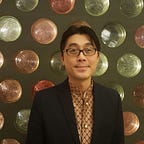CONSCIOUSNESS IN REPRESENTING BUDDHIST ARTS IN MUSEUM
The very first intention of this paper is to respond to the incident where a group of Buddhist disciples entered the museum and offered alms to a Burmese Buddha statue display in the Asian Civilization Museum (ACM), Singapore, as part of “Cities and Kings: Ancient Treasures from Myanmar exhibition.” This was a special exhibition of loans from the National Museums of Myanmar, ACM traveled spiritually potent Buddha images, in particular, a stone image in Dharmachakra Mudra from the Bagan Archaeological Museum which was said to have wish-fulfilling power. Out of respect, ACM organized a welcoming ceremony for all incoming loans with monks from the Burmese Buddhist Temple Singapore. However, visitors to the exhibition brought flower and water offerings to prostrate this Buddha, triggering a re-evaluation of museum policies on visitors’ behavior. This incident also brought back memory on a visit to the Bangkok National Museum: outside the museum complex, there are few shrines in place that allow locals to come in and offer alms, without paying an entrance ticket. Hence, curiosity arises in scrutinizing how do we see and present Buddhist art, either as an art object in the museum gallery or as a cultural object that needs to care for the representation authenticity. This paper is developing further views in comparing how few museums, approach and represent Buddhist art in their own country, respectively.
Art Object vs. Culture Object
To begin with, we explore the curating and display of Buddhist art in museums. We will not dive into details of the collection of Buddhist art by Europeans since the 19th century but more on exploring the contemporary ethical issues involved in representing Buddhist artifacts. Buddhist art refers to the rich and vast representations of religious images, sculpture, dance, mythology, and symbols that are deriving from Buddhism. Buddhist art exhibits distinctive forms and characteristics reflecting the diverse cultures and countries in which it has spread. The majority of the Buddhist art was displayed straightforward either in vitrines, set on high pedestals, or mounted on walls, together with object labels and text panels. Most sacred objects are often estranged from their original contexts of worship use and presented unadorned as works of art. Nevertheless, believer communities who value these art objects as consecrated, or spiritually significant, often engage with them in ways unforeseen by the secular museum.
As per literature research, the sacred objects of Buddhist art displayed in the United Kingdom and the American museums are shrined and installed to represent similar artifacts. Herein, it is worthwhile for us to discuss what we perceived as “ethnographic” as opposed to “artistic.” The ethnographic approach uses social context and less artistic concepts, while the artistic approach uses concepts like styles, materials, production methods. Another debate is between “authentic” and “secular,” and fellow curators recognized that visitors would better understand sacred objects if their religious meanings and contexts are explicitly spelled out and highlighted through displays i. Back thirty years ago, as part of the post-colonial reassessment and restitution process, the cultural groups and faith groups have successfully demanded greater access to sacred objects, and requiring museums to make special arrangements for the items.
For certain indigenous groups, this has meant restricting access to particular objects, reevaluating conservation practices that involve poisonous substances, and allowing ritual specialists to “care” for “their” objects (for example, ceremonially “feeding” them)ii. Hence, respectfully towards cultural sensitive objects and wishes of source, curators have increasingly opted to display religious objects as cultural objects, rather than as an art object. Not only the ethics in handling culturally specific codes of practice concerning objects but also provide a valuable experience for non-indigenous viewers.
Some research has also highlighted the importance of motivation in evaluating a person’s moral in religious conduct, and the effect of an action is judged not on the action itself or its results but the motivation behind it. Thus in the context of museum display, as long as displays of religious objects are with the right motivation, they would be beneficial. The flexibility entailed potentially renders a variety of different acceptable museum display techniques. For example, many artistic modes of the display are not inappropriate since they mostly adhere to the basic rules of respect. Moreover, the majority also opined that it is acceptable with non-believers viewing such objects from a non-religious, or non-Buddhist (i.e., artistic) perspective. Most argued, viewing such sacred objects has positive effects for practitioners and non-practitioners; opening up viewing to diverse audiences is regarded as beneficial.
So, while a Western curator might assume that displaying Buddhist art in the form of a shrine is much respectful and appropriate, from the Buddhist perspective, the issue appears not to be of particular importance. Instead, the onus is on the individual Buddhist, their level of mental devotion and motivation towards these objects, and the teachings they represent.
For these reasons, we see no contradiction in the creation of shrines (i.e., sacred space) within the secular context of museums. This concern may be part of a broader issue about Western museum logic; however, it is essential to highlight the diversity of Buddhist experience in the context of the contemporary diaspora. Culture, like museum displays, is considered multiply authored and shared experienced by diverse actors, to be sensitive enough, the investigation of representational practices commonly employed in museums remains essential.
For further readings, kindly access at https://drive.google.com/drive/u/0/recent
